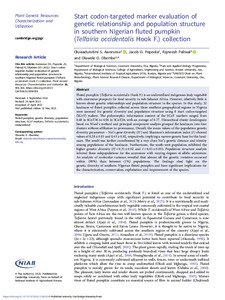| dc.contributor.author | Aworunse, O.S. |
| dc.contributor.author | Popoola, J.O. |
| dc.contributor.author | Paliwal, R. |
| dc.contributor.author | Obembe, O.O. |
| dc.date.accessioned | 2023-11-20T08:49:10Z |
| dc.date.available | 2023-11-20T08:49:10Z |
| dc.date.issued | 2023 |
| dc.identifier.citation | Aworunse, O.S., Popoola, J.O., Paliwal, R. & Obembe, O.O. (2023). Start codon-targeted marker evaluation of genetic relationship and population structure in southern Nigerian fluted pumpkin (Telfairia occidentalis Hook F.) collection. Plant Genetic Resources: Characterization and Utilization, 20(6), 406-416. |
| dc.identifier.issn | 1479-2621 |
| dc.identifier.uri | https://hdl.handle.net/20.500.12478/8334 |
| dc.description.abstract | Fluted pumpkin (Telfairia occidentalis Hook F.) is an underutilized indigenous leafy vegetable with enormous prospects for food security in sub-Saharan Africa. However, relatively little is known about genetic relationships and population structure in the species. In this study, 32 landraces of fluted pumpkin collected across three southern geographical regions in Nigeria were assessed for genetic diversity and population structure using 8 start codon-targeted (SCoT) makers. The polymorphic information content of the SCoT markers ranged from 0.48 in SCoT36 to 0.94 in SCoT28, with an average of 0.77. Hierarchical cluster dendrogram based on Ward's method and principal component analysis grouped the landraces into four clusters without affiliation to provenance. Overall, the mean values of the population genetic diversity parameters – Nei's gene diversity (H) and Shannon's information index (I) showed values of 0.28 ± 0.01 and 0.43 ± 0.02, respectively, implying a narrow genetic base for the landraces. The result was further corroborated by a very close Nei's genetic distance and identity among populations of the landraces. Furthermore, the south-west population exhibited the higher genetic diversity (H = 0.31 ± 0.02 and I = 0.45 ± 0.03). Population structure analysis inferred three subpopulations for the accessions with varying degrees of allelic admixture. An analysis of molecular variance revealed that almost all the genetic variation occurred within (99%) than between (1%) populations. The findings shed light on the genetic diversity of southern Nigerian fluted pumpkin and have significant implications for the characterisation, conservation, exploitation and improvement of the species. |
| dc.description.sponsorship | International Foundation for Science |
| dc.format.extent | 406-416 |
| dc.language.iso | en |
| dc.subject | Genetic Diversity |
| dc.subject | Population Structure |
| dc.subject | Telfairia |
| dc.subject | Food Security |
| dc.subject | Nigeria |
| dc.subject | Pumpkins |
| dc.title | Start codon-targeted marker evaluation of genetic relationship and population structure in southern Nigerian fluted pumpkin (Telfairia occidentalis Hook F.) collection |
| dc.type | Journal Article |
| cg.contributor.crp | Genebanks |
| cg.contributor.affiliation | Covenant University |
| cg.contributor.affiliation | Bowen University |
| cg.contributor.affiliation | International Institute of Tropical Agriculture |
| cg.coverage.region | Africa |
| cg.coverage.region | West Africa |
| cg.coverage.country | Nigeria |
| cg.coverage.hub | Headquarters and Western Africa Hub |
| cg.researchtheme | Biotech and Plant Breeding |
| cg.identifier.bibtexciteid | AWORUNSE:2023 |
| cg.isijournal | ISI Journal |
| cg.authorship.types | CGIAR and developing country institute |
| cg.iitasubject | Agronomy |
| cg.iitasubject | Biodiversity |
| cg.iitasubject | Food Security |
| cg.iitasubject | Genetic Improvement |
| cg.journal | Plant Genetic Resources: Characterization and Utilization |
| cg.notes | Open Access Article |
| cg.accessibilitystatus | Open Access |
| cg.reviewstatus | Peer Review |
| cg.usagerightslicense | Creative Commons Attribution 4.0 (CC BY 0.0) |
| cg.targetaudience | Scientists |
| cg.identifier.doi | https://doi.org/10.1017/s1479262123000308 |
| cg.iitaauthor.identifier | Rajneesh Paliwal: 0000-0001-6493-3289 |
| cg.futureupdate.required | No |
| cg.identifier.issue | 6 |
| cg.identifier.volume | 22 |

